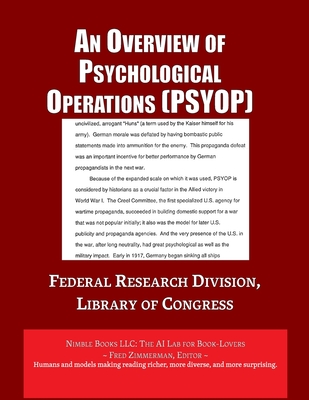Analysis of Psychological Operations (PSYOP)

Analysis of Psychological Operations (PSYOP)
This document written by the Federal Research Division of the Library of Congress for an unnamed federal agency provides a comprehensive overview of psychological operations (PSYOP) with a specific focus on military applications in the context of the Cold War era (up to November 1989). Key Points: -Definition of PSYOP: The document clarifies the evolving definition of PSYOP, from influencing enemy attitudes in wartime to a broader scope encompassing peacetime activities aimed at shaping emotions, attitudes, and behaviors of foreign groups to achieve political and military objectives. -Historical Context: The paper explores historical examples of PSYOP, highlighting instances like Judith and Holofernes, Ghengis Khan, and the American Revolution, showcasing the enduring value of psychological tactics in warfare. -Soviet PSYOP: The document delves into the Soviet Union's extensive and sophisticated PSYOP machinery, emphasizing their philosophy of constant ideological warfare against the capitalist world. It details the roles of various Soviet agencies like the International Department, Propaganda Department, and the KGB in conducting active measures and disinformation campaigns. -United States PSYOP: The paper examines the US approach to PSYOP, characterized by a historical reluctance towards peacetime PSYOP and a reactive posture. It discusses the challenges faced by the US in countering Soviet propaganda and the need for improved coordination and resources. -Evolving Landscape: The document acknowledges the changing nature of warfare, with the rise of unconventional conflicts and low-intensity conflicts, necessitating a greater emphasis on PSYOP. Strengths of the Document: -Comprehensive Overview: The paper provides a well-structured and informative analysis of PSYOP, covering historical examples, theoretical frameworks, and contemporary applications. -Comparative Approach: The document effectively compares and contrasts the Soviet and US approaches to PSYOP, highlighting their strengths and weaknesses. -Emphasis on Contemporary Challenges: The paper acknowledges the changing nature of warfare and the increasing importance of PSYOP in the context of unconventional and low-intensity conflicts. Potential Limitations: -Dated Information: As the document predates November 1989, it does not consider the significant geopolitical shi
PRP: 123.59 Lei
Acesta este Prețul Recomandat de Producător. Prețul de vânzare al produsului este afișat mai jos.
98.87Lei
98.87Lei
123.59 LeiLivrare in 2-4 saptamani
Descrierea produsului
This document written by the Federal Research Division of the Library of Congress for an unnamed federal agency provides a comprehensive overview of psychological operations (PSYOP) with a specific focus on military applications in the context of the Cold War era (up to November 1989). Key Points: -Definition of PSYOP: The document clarifies the evolving definition of PSYOP, from influencing enemy attitudes in wartime to a broader scope encompassing peacetime activities aimed at shaping emotions, attitudes, and behaviors of foreign groups to achieve political and military objectives. -Historical Context: The paper explores historical examples of PSYOP, highlighting instances like Judith and Holofernes, Ghengis Khan, and the American Revolution, showcasing the enduring value of psychological tactics in warfare. -Soviet PSYOP: The document delves into the Soviet Union's extensive and sophisticated PSYOP machinery, emphasizing their philosophy of constant ideological warfare against the capitalist world. It details the roles of various Soviet agencies like the International Department, Propaganda Department, and the KGB in conducting active measures and disinformation campaigns. -United States PSYOP: The paper examines the US approach to PSYOP, characterized by a historical reluctance towards peacetime PSYOP and a reactive posture. It discusses the challenges faced by the US in countering Soviet propaganda and the need for improved coordination and resources. -Evolving Landscape: The document acknowledges the changing nature of warfare, with the rise of unconventional conflicts and low-intensity conflicts, necessitating a greater emphasis on PSYOP. Strengths of the Document: -Comprehensive Overview: The paper provides a well-structured and informative analysis of PSYOP, covering historical examples, theoretical frameworks, and contemporary applications. -Comparative Approach: The document effectively compares and contrasts the Soviet and US approaches to PSYOP, highlighting their strengths and weaknesses. -Emphasis on Contemporary Challenges: The paper acknowledges the changing nature of warfare and the increasing importance of PSYOP in the context of unconventional and low-intensity conflicts. Potential Limitations: -Dated Information: As the document predates November 1989, it does not consider the significant geopolitical shi
Detaliile produsului









